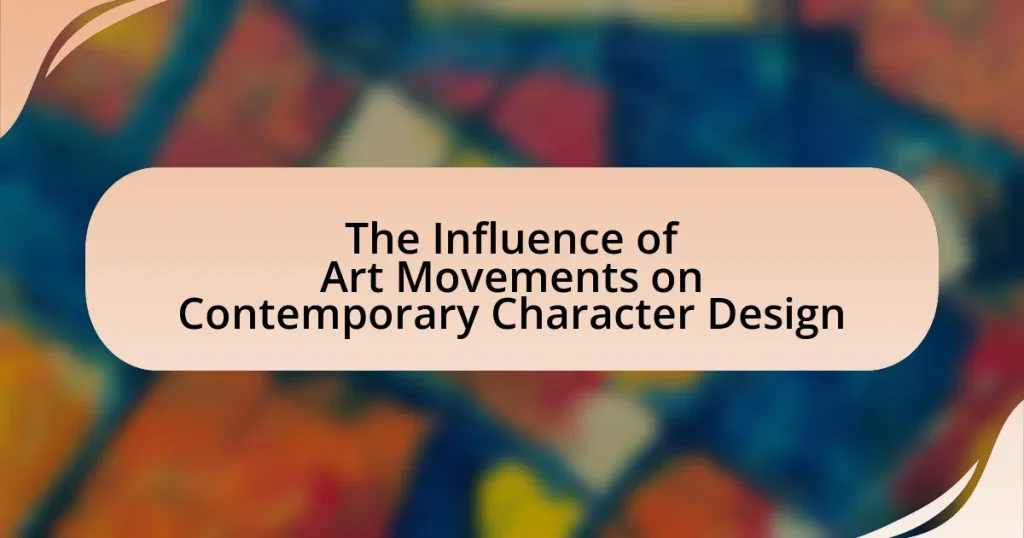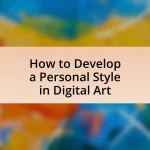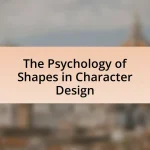The article examines the significant influence of historical art movements on contemporary character design, highlighting how movements such as Cubism, Expressionism, and Surrealism shape visual styles, thematic elements, and character archetypes. It discusses key characteristics of these movements, their reflection of cultural shifts, and the importance of understanding art history for character designers. Techniques for incorporating art movements into character design, as well as resources for further study, are also explored, emphasizing best practices and common pitfalls to avoid. Overall, the article provides a comprehensive overview of how art movements inform and enhance modern character design across various media.
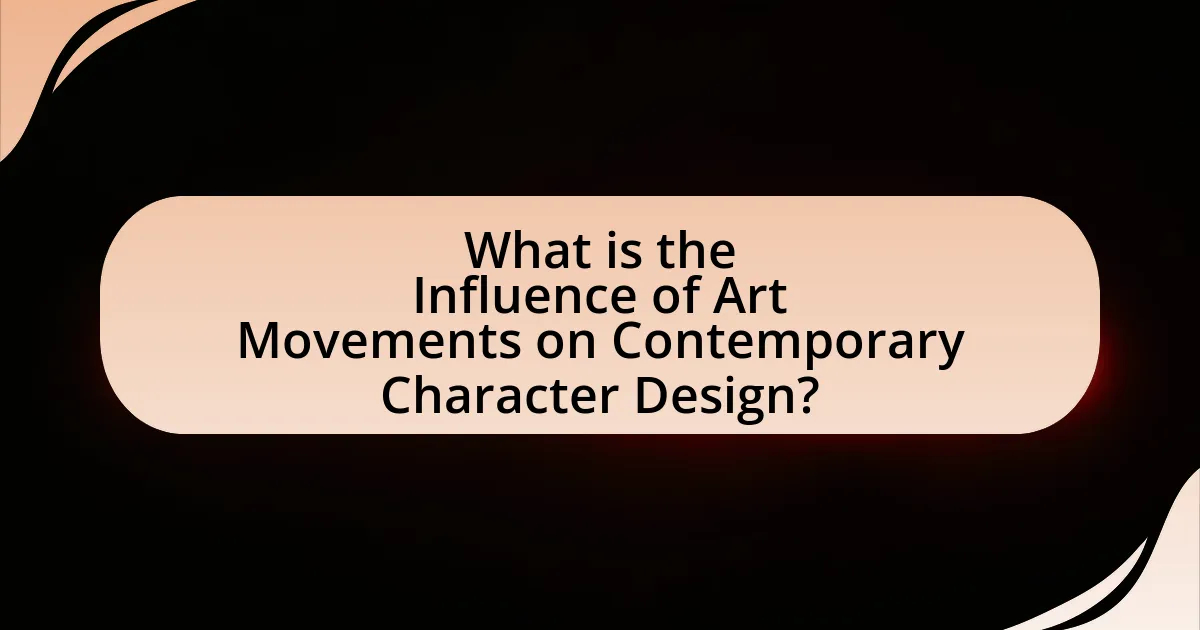
What is the Influence of Art Movements on Contemporary Character Design?
Art movements significantly influence contemporary character design by providing stylistic frameworks and thematic inspiration. For instance, the bold colors and geometric shapes of Cubism can be seen in character designs that emphasize abstract forms, while the emotional expressiveness of Expressionism informs character features that convey deeper psychological states. Additionally, the minimalist aesthetics of Modernism have led to streamlined character designs that focus on essential traits, enhancing clarity and impact. Historical examples include the influence of Surrealism on fantasy character designs, where dream-like qualities and unexpected juxtapositions create unique visual narratives. These art movements shape not only the visual aspects but also the cultural and emotional resonance of characters in modern media.
How have historical art movements shaped character design today?
Historical art movements have significantly shaped character design today by influencing visual styles, thematic elements, and character archetypes. For instance, the Renaissance introduced a focus on realism and anatomical accuracy, which can be seen in modern character designs that prioritize lifelike proportions and expressions. The Impressionist movement emphasized color and light, inspiring contemporary artists to explore vibrant palettes and dynamic lighting in character illustrations. Additionally, movements like Art Deco and Surrealism have contributed to the stylization and abstraction of characters, leading to unique and imaginative designs that reflect cultural narratives. These influences are evident in various media, including animation, video games, and graphic novels, where character design often draws from historical aesthetics to create relatable and visually compelling figures.
What are the key characteristics of major art movements that influence character design?
Major art movements significantly influence character design through distinct characteristics such as style, color, form, and thematic elements. For instance, the Impressionist movement emphasizes light and color, leading to characters that reflect dynamic atmospheres and emotional depth. In contrast, Cubism breaks down forms into geometric shapes, inspiring character designs that challenge traditional perspectives and create unique visual narratives. Additionally, Surrealism introduces dream-like qualities and unexpected juxtapositions, allowing for imaginative and unconventional character traits. These characteristics are evident in contemporary character design, where artists draw from these movements to create visually compelling and thematically rich characters that resonate with audiences.
How do different art movements reflect cultural shifts in character design?
Different art movements reflect cultural shifts in character design by embodying the values, aesthetics, and social contexts of their respective eras. For instance, the Renaissance emphasized realism and human emotion, leading to character designs that showcased anatomical accuracy and expressive features, as seen in works by artists like Leonardo da Vinci. In contrast, the Art Nouveau movement introduced stylized forms and organic lines, reflecting a cultural fascination with nature and the decorative arts, which influenced character designs to become more fluid and ornamental. The rise of Modernism brought about abstraction and minimalism, prompting character designs to focus on essential forms and colors, as exemplified by the works of Pablo Picasso. Each movement not only shaped the visual representation of characters but also mirrored the societal changes, such as shifts in gender roles, technological advancements, and cultural identities, thereby illustrating how art movements serve as a lens through which cultural evolution can be observed in character design.
Why is understanding art movements important for character designers?
Understanding art movements is crucial for character designers because it provides historical context and stylistic inspiration that can enhance their creative process. By studying various art movements, such as Impressionism or Surrealism, character designers can incorporate unique visual elements and thematic concepts into their designs, allowing for more innovative and culturally resonant characters. For instance, the use of bold colors and dynamic forms from Expressionism can lead to more emotionally impactful character designs. This knowledge not only enriches the designer’s toolkit but also helps in creating characters that resonate with audiences by reflecting broader artistic trends and cultural narratives.
How can knowledge of art movements enhance creativity in character design?
Knowledge of art movements enhances creativity in character design by providing a diverse range of styles, techniques, and philosophies that can inspire unique character concepts. For instance, understanding the principles of Cubism can lead to innovative geometric shapes in character forms, while the emotional depth of Expressionism can inform character backstories and emotional expressions. Historical context, such as the impact of Surrealism on visual storytelling, can also encourage designers to explore unconventional narratives and aesthetics. This multifaceted approach allows character designers to break traditional boundaries and create more compelling and original designs.
What role does art history play in the evolution of character design styles?
Art history significantly influences the evolution of character design styles by providing a rich context of visual language, techniques, and thematic exploration. Historical art movements, such as Impressionism, Cubism, and Surrealism, have introduced unique aesthetics and conceptual frameworks that contemporary character designers draw upon to create diverse and innovative characters. For instance, the bold colors and dynamic forms of Expressionism can be seen in modern animated characters, while the geometric shapes of Cubism inspire stylized character designs in video games. This interplay between historical art styles and contemporary design practices demonstrates how art history serves as a foundational resource, shaping the visual identity and narrative depth of character design across various media.
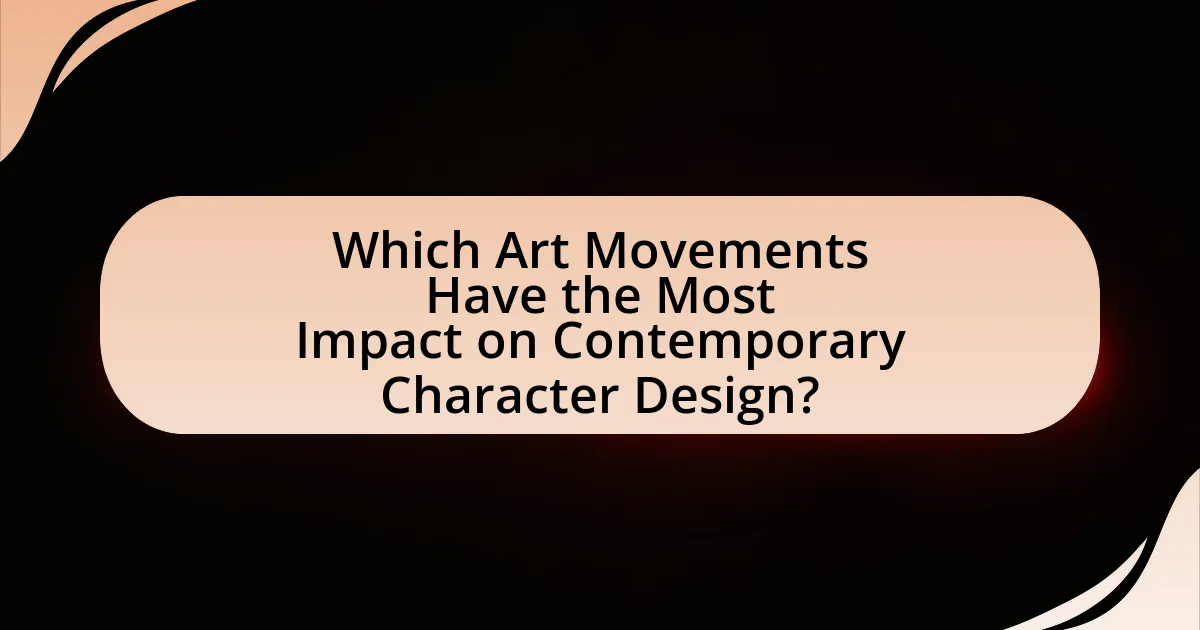
Which Art Movements Have the Most Impact on Contemporary Character Design?
The art movements that have the most impact on contemporary character design are Surrealism, Pop Art, and Japanese Manga. Surrealism influences character design through its emphasis on dream-like imagery and unconventional forms, allowing designers to create imaginative and often bizarre characters. Pop Art contributes through its bold colors and graphic styles, which are frequently utilized in modern character aesthetics to appeal to contemporary audiences. Japanese Manga has significantly shaped character design with its distinct visual style, characterized by exaggerated features and expressive emotions, which has become a global standard in animation and gaming. These movements collectively inform the visual language and creative approaches in contemporary character design, making them foundational to the field.
What are the defining features of the most influential art movements?
The defining features of the most influential art movements include distinct styles, thematic focus, and innovative techniques that reflect cultural and societal changes. For instance, Impressionism emphasized light and color through loose brushwork, capturing fleeting moments in everyday life, while Cubism deconstructed objects into geometric forms, challenging traditional perspectives. Surrealism explored the unconscious mind, using dream-like imagery to provoke thought and emotion. Each movement not only introduced new aesthetics but also influenced subsequent artistic expressions, shaping the evolution of art and its impact on contemporary character design.
How does Impressionism influence character design aesthetics?
Impressionism influences character design aesthetics by emphasizing the use of light, color, and movement to convey emotion and atmosphere. This art movement, which emerged in the late 19th century, encourages designers to focus on capturing fleeting moments and the essence of characters rather than detailed realism. For instance, the use of vibrant, non-representational colors and loose brushwork in Impressionist paintings can inspire character designers to adopt a more expressive and dynamic approach, allowing for greater emotional depth and personality in their designs. This influence is evident in contemporary animation and video games, where characters often exhibit exaggerated features and fluid movements that reflect the spontaneity and vibrancy characteristic of Impressionist art.
In what ways does Surrealism contribute to character design concepts?
Surrealism contributes to character design concepts by introducing dream-like imagery and unconventional forms that challenge reality. This art movement encourages designers to explore the subconscious, leading to characters that embody bizarre proportions, unexpected color palettes, and fantastical elements. For instance, artists like Salvador Dalí and René Magritte utilized distorted perspectives and illogical scenes, which inspire character designers to create unique and imaginative figures that evoke emotional responses. The incorporation of surrealistic elements allows for greater creativity and innovation in character design, pushing the boundaries of traditional aesthetics and inviting audiences to engage with characters on a deeper psychological level.
How do modern interpretations of classic art movements affect character design?
Modern interpretations of classic art movements significantly influence character design by incorporating stylistic elements and thematic concepts from those movements. For instance, the use of bold colors and geometric shapes from Cubism can be seen in character designs that emphasize abstraction and fragmentation, allowing for unique visual storytelling. Additionally, the emotional expressiveness of Expressionism often informs character facial features and body language, enhancing the narrative depth. Historical context shows that artists like Pablo Picasso and Edvard Munch have inspired contemporary designers to explore new dimensions in character portrayal, leading to innovative designs that resonate with audiences.
What are some examples of contemporary character designs inspired by past art movements?
Contemporary character designs inspired by past art movements include the use of Art Deco aesthetics in animated films like “The Great Gatsby” and the incorporation of Surrealism in characters from “Adventure Time.” Art Deco’s geometric shapes and luxurious details are evident in the stylized characters and environments, while Surrealism’s dreamlike qualities influence the whimsical and bizarre designs seen in “Adventure Time.” These examples demonstrate how historical art movements continue to shape modern visual storytelling, blending traditional elements with contemporary narratives.
How do artists blend multiple art movements in character design?
Artists blend multiple art movements in character design by integrating stylistic elements, themes, and techniques from various historical and contemporary art movements. For instance, a character design may combine the bold colors and geometric shapes of Cubism with the emotional expressiveness of Expressionism, creating a unique visual narrative. This approach allows artists to draw from a diverse palette of influences, enhancing creativity and depth in their designs. The successful blending of these movements can be seen in works that utilize the surreal aspects of Dadaism alongside the clean lines of Minimalism, resulting in characters that are both visually striking and conceptually rich.

What Techniques Do Character Designers Use to Incorporate Art Movements?
Character designers incorporate art movements through techniques such as stylistic adaptation, color theory application, and thematic exploration. Stylistic adaptation involves borrowing visual elements from specific art movements, like the bold lines of Art Deco or the fluid forms of Art Nouveau, to create distinctive character aesthetics. Color theory application utilizes palettes inspired by movements like Impressionism, where color is used to evoke emotion and atmosphere, enhancing character depth. Thematic exploration allows designers to reflect the philosophies of movements, such as Surrealism, by integrating dream-like qualities into character narratives. These techniques are validated by the historical influence of art movements on visual culture, demonstrating their ongoing relevance in contemporary design practices.
How can character designers apply principles from various art movements?
Character designers can apply principles from various art movements by integrating stylistic elements, color palettes, and thematic concepts that define those movements into their character creations. For instance, a designer might draw inspiration from Cubism by using geometric shapes to construct a character’s form, or they could adopt the vibrant colors and emotional expressiveness of Expressionism to convey a character’s personality. Historical examples include the influence of Art Nouveau on character design in animated films, where flowing lines and organic forms are prevalent. By studying these movements, designers can enhance their work, making it visually compelling and culturally resonant.
What techniques are used to mimic the styles of different art movements?
Techniques used to mimic the styles of different art movements include the application of specific color palettes, brushwork, composition, and thematic elements characteristic of those movements. For instance, Impressionism often employs loose brush strokes and a focus on light, while Cubism utilizes geometric shapes and fragmented forms. Artists may also study historical works to understand the context and techniques used, such as the layering methods of the Old Masters or the bold outlines of Pop Art. These techniques are validated by art education practices that emphasize the importance of mastering historical styles to inform contemporary design, as seen in various art schools and workshops.
How do color theory and composition from art movements influence character design?
Color theory and composition from art movements significantly influence character design by providing a framework for visual storytelling and emotional resonance. For instance, the use of complementary colors, as seen in the works of the Impressionists, can create dynamic contrasts that enhance a character’s personality traits. Additionally, the principles of composition, such as balance and focal points derived from movements like Cubism, guide the arrangement of elements in character design, ensuring that the character stands out and conveys the intended narrative. Historical examples include the bold color palettes of Fauvism, which evoke strong emotions, and the geometric forms of Constructivism, which can suggest modernity and innovation in character aesthetics. These artistic foundations help designers create characters that are not only visually appealing but also rich in meaning and context.
What tools and resources are available for character designers to study art movements?
Character designers can utilize a variety of tools and resources to study art movements, including online databases, art history books, and digital platforms. Online databases such as JSTOR and Google Scholar provide access to scholarly articles and research papers on various art movements, allowing designers to explore historical contexts and influences. Art history books, like “Art Through the Ages” by Helen Gardner, offer comprehensive overviews of different movements, styles, and key artists, which can inform character design. Additionally, digital platforms like Pinterest and Behance allow designers to visually explore and curate inspiration from various art movements, facilitating a deeper understanding of aesthetic principles and techniques. These resources collectively enhance the knowledge base of character designers, enabling them to incorporate diverse artistic influences into their work.
Which books and online resources provide insights into art movements and character design?
Books such as “Art History: A Very Short Introduction” by Dana Arnold and “The Story of Art” by E.H. Gombrich provide comprehensive insights into various art movements, which are essential for understanding character design. Online resources like the Khan Academy’s Art History section and the MoMA website offer accessible information on art movements and their influence on contemporary design practices. These sources are validated by their academic credibility and extensive coverage of art history, making them reliable for studying the intersection of art movements and character design.
How can workshops and courses enhance understanding of art movements in character design?
Workshops and courses can significantly enhance understanding of art movements in character design by providing structured learning experiences that focus on historical context, techniques, and stylistic elements. These educational settings often include hands-on projects that allow participants to apply concepts from various art movements, such as Impressionism or Cubism, directly to their character designs. For instance, a course might explore how the bold colors and dynamic forms of Expressionism can influence character aesthetics, enabling designers to create more emotionally resonant characters. Additionally, workshops often feature critiques and discussions led by experienced instructors, which can deepen participants’ insights into how different art movements have shaped contemporary design practices. This combination of theoretical knowledge and practical application fosters a comprehensive understanding of the relationship between art movements and character design.
What are best practices for integrating art movements into character design?
Best practices for integrating art movements into character design include thorough research of the specific art movement, understanding its visual language, and applying its principles to character attributes. For instance, studying Cubism can inspire fragmented shapes and abstract forms in character silhouettes, while Art Nouveau can influence flowing lines and organic patterns in clothing design. Historical context is crucial; for example, the Dada movement’s emphasis on absurdity can lead to unconventional character traits or narratives. Additionally, blending elements from multiple movements can create unique designs, as seen in contemporary works that merge Surrealism with Pop Art. This approach not only enriches character depth but also resonates with audiences familiar with these artistic styles.
How can designers effectively research and select art movements for their projects?
Designers can effectively research and select art movements for their projects by utilizing a systematic approach that includes studying historical contexts, analyzing visual elements, and exploring cultural significance. This method allows designers to understand the evolution of art movements and their impact on contemporary design. For instance, examining the characteristics of movements like Bauhaus or Surrealism can provide insights into form, color, and composition that are relevant to modern character design. Additionally, resources such as art history books, academic journals, and online databases can offer valuable information and examples, reinforcing the designer’s ability to make informed choices that resonate with their intended audience.
What common pitfalls should designers avoid when drawing inspiration from art movements?
Designers should avoid the pitfall of superficial imitation when drawing inspiration from art movements. Superficial imitation occurs when designers replicate visual elements without understanding the underlying concepts and philosophies that define those movements. For instance, the Bauhaus movement emphasized functionality and simplicity, which should inform design choices rather than merely copying geometric shapes. Additionally, designers must steer clear of anachronism, where they apply historical styles inappropriately to modern contexts, leading to designs that feel disjointed or irrelevant. Understanding the historical context and intent behind art movements ensures that the inspiration is meaningful and relevant to contemporary design.
